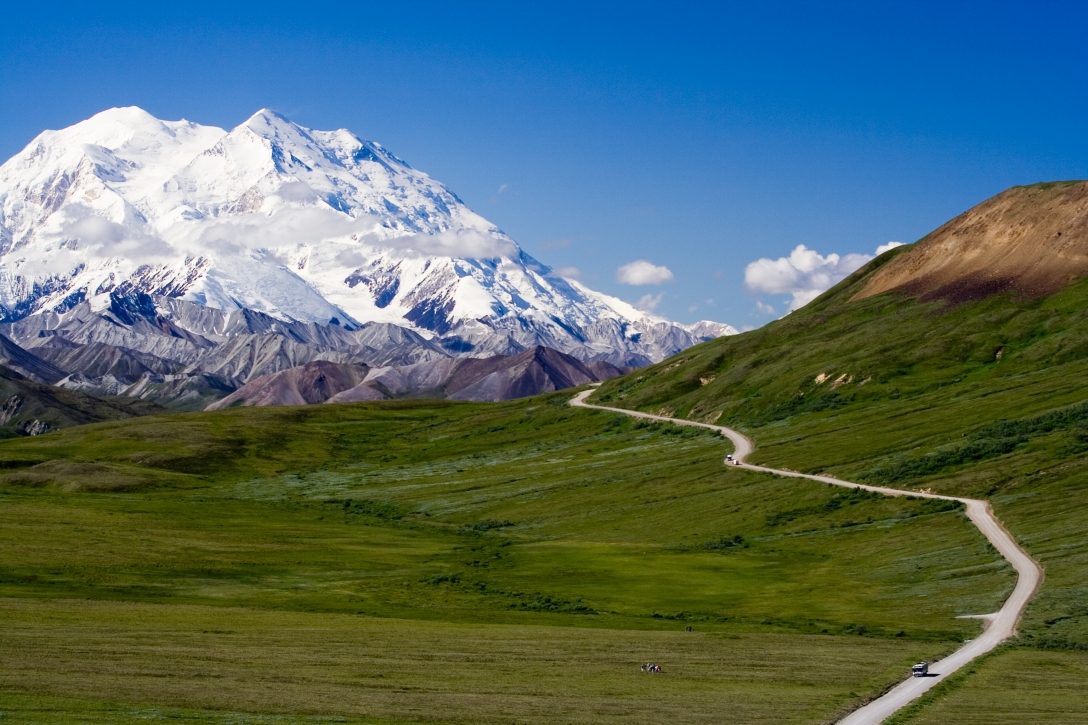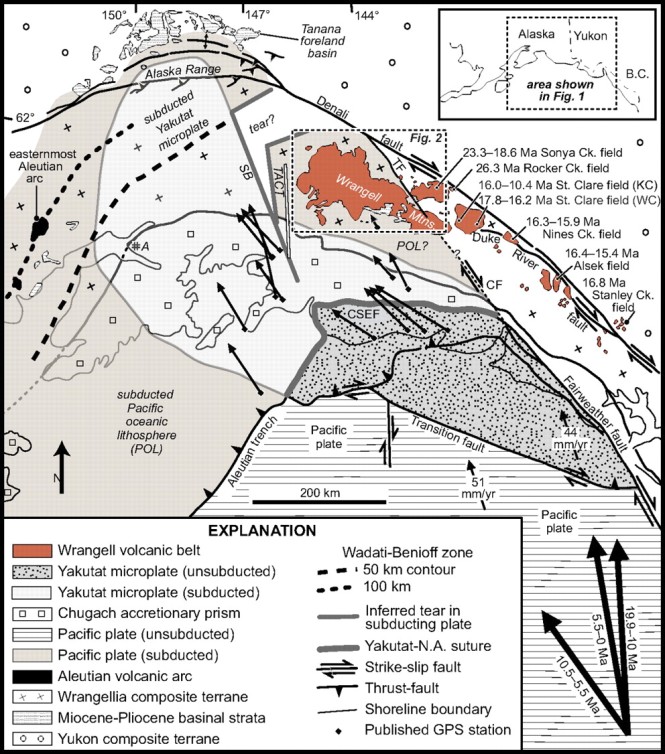
Mount Denali: Not a volcano.
I recently stumbled across an article about the Denali Gap, a region along the Alaska trench where there are no volcanoes generated by subduction. The gist of the article is that Denali lies right where volcanoes would be expected, but it is not a volcano. However, some magma movement was recently detected. The geologist quoted mentioned that the reason that there are no volcanoes there is due to “flat slab subduction,” where the subducting plate does not immediately sink and melt, but rather stays mostly flat, while being overridden. This got me to thinking about a number of things that can affect subduction zone volcanism that aren’t covered in most peoples’ education about geology.
For those who need to be reminded of the basics, here they are: When two tectonic plates that are moving towards each other collide, one of the two is pushed below the other and sinks into the mantle. This plate carries water and other volatile substances with it. Water and other volatile substances lower the melting point of rock and increase its buoyancy. Therefore, when the plate sinks into the mantle, it heats up, creating buoyant, molten rock. This buoyant, molten rock rises up, and eventually melts through the plate on top, creating volcanoes. This buoyant magma is created at the point where the subducting plate reaches approximately 100 km depth. The distance from the trench to the volcanic arc depends on the subduction angle, typically between 30-70 degrees, with a steeper angle creating an arc that is closer to the trench. Generally, this is about 100 km inland from the trench. The magmas produced are usually from the calc-alkaline series, which are highly oxidized and water rich. In contrast, the magma of midocean ridges consists of tholeiite, which is reduced (the opposite of oxidized), and generally contains less water. (If you want to read about oxidation states, go read some chemistry books.)
What is interesting is that along some subduction zones, there are large gaps where no volcanoes exist, and in some places, subduction volcanoes erupt tholeiitic lavas. Additionally, in some places, volcanism extends much further from the trench than one would expect. Last, but not least, there are areas where large ignimbrite flare-ups (lots of large caldera forming eruptions over a geologically short period of time) have occurred. While there are still plenty of volcanic mysteries that befuddle geologists, most of the aforementioned phenomena can be explained by flat slab subduction, slab rollback, delamination, slab windows, and back-arc basins. This is the first in a short series of articles explaining these.
Disclaimer: I am not a geologist. This is only based on what I have learned from reading on these topics. I may not have interpreted things perfectly, and I may have missed some important theories. If you ARE a geologist, I welcome you to come here and prove me wrong or argue for or against the theories presented here.
Flat Slab Subduction
As mentioned at the beginning of this article, one phenomenon that can create gaps in a volcanic arc is flat slab subduction. This is pretty much exactly what it sounds like. Instead of the subducting plate immediately sinking into the mantle at a 30-70 degree angle, the plate remains pretty much horizontal while the lighter plate simply overrides it. Not surprisingly, this tends to lift up the overriding plate, creating great mountain ranges, like the Rocky Mountains of the American cordillera, or the Andes of Peru. (For further reading, look up the Laramide Orogeny, which is one of the best studied instances of flat slab subduction.) Interestingly, though, much of the mountain building may actually occur after flat slab subduction ends. (We will get to this in the next article.) Since the plate does not dive into the mantle as soon as it is overridden, it goes much further inland before it reaches the depth where the volatile substances begin creating melt. Without hot, buoyant, liquid magma, there is nothing to fuel the volcanoes of the existing arc, so these volcanoes become extinct. Volcanism may push back to where the subducting plate finally reaches sufficient depth to create melt, but often, the lower plate simply stops sinking for a time. In this case, there is a complete stoppage to volcanism, at least for a while. This may be the calm before the storm, though, as we will see in the next article of this series.

Figure: The volcanoes of Mexico are far inland from the trench due to flat slab subduction. (Compare to the volcanoes of Guatemala, El Salvador and Honduras.)
While the consequences of flat slab subduction are well understood, the causes are still somewhat under contention. The simplest explanation is that the rate of movement of the overriding plate and the subducting plate have little to do with each other. In this case, the overriding plate is moving rapidly in comparison to the rate of subduction. There is some support for this based on the opposite occurrence, slab rollback and back-arc basin formation, which I will get to later. Also, flat slab subduction occurs primarily where there is rapid convergence between the two plates. This is not the only theory, though.
Another major theory stems from the observation that almost every instance of flat slab subduction occurs near where an oceanic plateau or aseismic ridge (a ridge that is not a spreading center) is being subducted under a continent. Of course, the presence of a ridge makes for thicker, stronger crust, meaning that it is harder to deform it and make it bend down into the mantle. This is not the only force at play, though. While a ridge may not be proper continental crust, most aseismic ridges consist of lighter material than typical ocean crust. This makes them more buoyant, and thus resist sinking into the mantle. Along the Andes, you can see two major gaps that fit this description: The Peruvian gap, apparently caused by the Nazca ridge and the Pampean gap, associated with the Juan Fernandez ridge.

Figure: The Pampean gap occurs between the Southern volcanic zone and the central volcanic zone. The Peruvian gap is between the central and Northern volcanic zones.
The last theory is that flat slab subduction takes place where the mantle is cooler and therefore more viscous. In this case, the subducting plate is held in place by the thicker, more solid mantle material, while the overriding plate pushes over it. Suction also plays a role in this model. In order for the lower plate to fall away and sink into the mantle, mantle material must move up into the newly formed gap between the plates. If the mantle material is too thick to be sucked up into this space, then the lower plate can’t sink! It’s notable that none of these theories are mutually exclusive of each other. Multiple factors may be involved in flat slab subduction.
So, what’s really going on at the Denali gap? Well, it appears that this gap is due to the subduction of the Yakutat microplate. This microplate seems to be made of thick, low density material. It may be part of the continental shelf that became attached to the Pacific plate when transform faulting began along the Queen Charlotte fault. Originally, the plate margin was an arced trench, but when the Pacific plate arrived, it turned into an essentially linear fault. Parts of one or both plates would have to have broken off and welded to the other in order to change the shape of the plate margin. Alternatively, it could simply have originated as a typical oceanic plateau. In either case, this lighter material creates an area of low density that is subducting, leading to flat slab subduction and a volcanic gap.
Matt






Pingback: Someone Put The Rockie Mountains In The Wrong Place